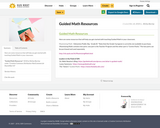
Here are some resources that will help you get started with teaching Guided Math in your classroom.
- Subject:
- Math
- Material Type:
- Activity/Lab
- Assessment
- Homework/Assignment
- Primary Source
- Reading
- Teaching/Learning Strategy
- Date Added:
- 10/22/2018

Here are some resources that will help you get started with teaching Guided Math in your classroom.
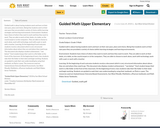
Guided math is about having students work and learn at their own pace, place and choice. Being that students work at their own pace they are provided a variety of choice within learning strategies and learning environments.
Environment: Students have choice of where they want to work and how they want to work. They are able to work at their desks, at a table, on the couch/carpet or at the computers. They are able to choose to work alone, work with technology, work with a pair or work with a teacher.
Learning: At the beginning of each outcome students receive a document which is very structured information about where they are and where they need to go. This document also displays student achievement. **see below** Each student keeps their work in a file folder at the front of the classroom. At the beginning of every class students take their file folder to their desk and begin working. Students are guided to seek their own understanding by using their textbook, an iPad or a peer. The resources used are Saskatchewan Outcome Based Assessments, Sun West Moodle, Mathletics, ePearson textbooks and Math Makes Sense Textbooks.
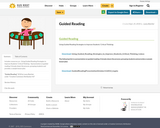
Includes resources on:
-Using Guided Reading Strategies to Improve Students’ Critical Thinking
- Apresentation on guided reading. It breaks down the process, grouping students and provides a sample lesson plan.
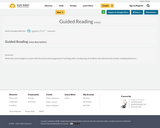
Materials and strategies to assist with the instructional approach of working with a small group of students who demonstrate similar reading behaviours.
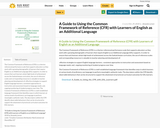
The Common Framework of Reference (CFR) is a criterion-referenced performance scale that supports educators as they work with a growing demographic of learners that require English as an Additional Language (EAL) supports. In order to ensure that such learners attain high levels of achievement across the Saskatchewan curriculum, the use of reference scales and corresponding resources is valuable to teacher planning and development of:
effective strategies to support English language learners; consistent approaches to instruction and assessment based on language needs; and, ongoing monitoring of student progress over time.
The Common Framework of Reference (CFR) is a well-established language framework that identifies ways in which learners at various levels of proficiency use language to perform meaningful, authentic tasks. The descriptors within the CFR identify observable behaviours that can be structured to support the attainment of provincial curriculum outcomes for EAL learners.
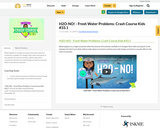
What happens to a single ecosystem when the amount of freshwater available in it changes? Not really much good. In this episode of Crash Course Kids, Sabrina talks about ecosystems and how one small change can lead to a cascade effect in the entire ecosystem.
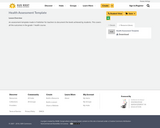
An assessment template made in Publisher for teachers to document the levels achieved by students. This covers all the outcomes in the grade 1 health course.

Explain to the students that, in small groups, they will be creating a personal action plan for eating healthy.

Health Science 20 - Excrement Lab & Case Studies - Dakota de Caux
In order to explore diagnostic techniques and pathologies associated with the urinary and digestive systems, I had students complete an excrement lab activity and diagnose case studies related to the samples that they analyzed. During the lab, they conducted macroscopic and chemical analysis of teacher created urine and stool samples. Based on their data, they were asked to discuss potential pathologies that could be causing they symptoms that they observed. Once the lab reports were complete, each student was assigned a case study that was connected to a specific urine or feces sample and were asked to come up with a diagnosis that they would present to the class. Students were given two class periods to conduct their research and put together their presentations.
This activity gave students the opportunity to apply their knowledge of the digestive and excretory systems while also making connections to real life medical applications through the completion of artificial excrement analysis and case study diagnosis. Students were noticeably engaged during all segments of this activity. The knowledge and skills that students acquired will help them be critical when discussing their own medical results with health care professionals. The case study portion of the activity encouraged students to locate reliable sources and recognize the need for additional test results or patient history in order to determine a diagnosis because certain excrement results can suggest numerous pathologies. We also discussed the importance of patient honesty in the selection of a correct diagnosis. This learning activity and assessment strategy encourages the development of critical thinking, collaboration, communication, and computer/digital technologies.
Purpose:
The purpose of this activity is to preform an analysis on a variety of urine and stool samples in order to understand the procedure and purpose of these tests in the health care world.
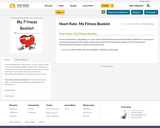
Create and implement, with guidance, as a class, health-related fitness plan targeting the
health-related fitness component of cardiovascular endurance that includes setting a
personal goal form improvement, applies the F.I.T.T. principle, and incorporates daily
moderate to vigorous movement activity
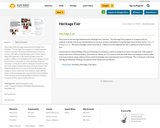
This is part of the Heritage Saskatchewan Heritage Fairs initiative. “The Heritage Fairs program is an opportunity for students in grades 4-8 all over Saskatchewan to research, present, and explore Living Heritage topics of their choice.” https://heritagesask.ca/ We had local judges assess the projects. 3 Went on to the Regional fair and 1 is going on to the Provincial Fair.
Connection to critical thinking: Historical Thinking is a competency which is designed around 6 concepts that “help students explore the forest of historical data.” Ken Osborne. Better put, it is a way to critically think about and engage in history rather than have students simply address history at the knowledge and comprehension level of thinking. This is all based on the book The Big Six Historical Thinking Concepts by Peter Sexias and Tom Morton.
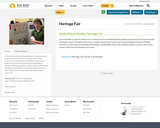
In Social Studies 8, students worked over a 6-week period to create Heritage Fair projects on a topic of their choice connected to Canadian history. Throughout the process, I taught a series of mini-lessons that covered the Big Six Historical Thinking Concepts, as well as research methods and techniques. The flexibility of the project allowed students to cover a wide variety of topics within the Social Studies 8 curriculum.
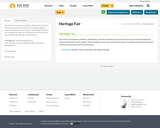
This artifact encompasses creativity, collaboration, and critical thinking as it
presents the process of creating heritage fair projects with grades 4 and 5 students.
The heritage fair project was completed through a co-teaching and focused on
student-centered learning and project-based learning.
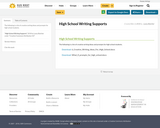
The following is a list of creative writing ideas and prompts for high school students.
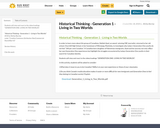
Students will view and react to the video/readings "GENERATION ONE: LIVING IN TWO WORLDS".

This lesson utilizes the framework of Historical Thinking Concepts. Historical thinking is defined as “the reading, analysis, and writing that is necessary to develop our understanding of the past”. (Teachinghistory.org)
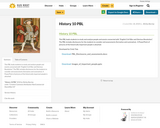
This PBL leads students to study and analyze people and events connected with "English Civil War and Glorious Revolution". The PBL includes disclosures for the students to consider and assessments (formative and summative). A PowerPoint of pictures of the historically important people is attached.
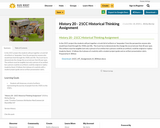
In the 21CC project the students will put together a trunk full of artifacts or ‘keepsakes’ from the perspective anyone who would have lived through the 1920s and 30s. The truck has to demonstrate the change the occurred over that 20 year span. The artifacts must be tangible (not only a picture of an artifact but a picture could be an artifact); could be original or replica (made by them). It follows the 6 phases of creativity with a student project guide and an artifact presentation rubric.
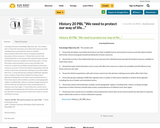
Learning Outcomes
Knowledge Objectives (K) - The student will:
1. Know that all nations must determine how to use their available human and material resources and that determination will involve choices among perceived/real demands on those resources.
2. Know that scarcity is the relationship that occurs because the unlimited wants exceeds the limited resources available to meet those wants.
3. Know that major events/situations such as wars will affect the resources a nation has available and will influence how those resources are used.
4. Know that distinct populations will seek to have control over the decision making process which affect their lives.
5. Know that groups seeking to fulfill their agendas have a number of alternative methods to achieve those agendas including the use of violent and nonviolent tactics.
6. Know that nations will sometimes consider certain geographic regions, including other nations, as being strategic importance to their interests and will seek to have a preponderance of influence over that region.
7. Know that every society has to establish some fundamental criteria that can be used to justify the allocation of supreme power within that society to certain individual or groups.
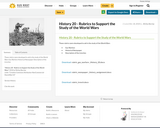
These rubrics were developed to aid in the study of the World Wars
Gas Warfare
Historical Newspaper
Description of the trenches